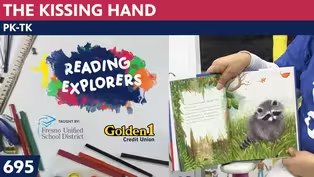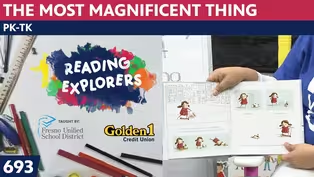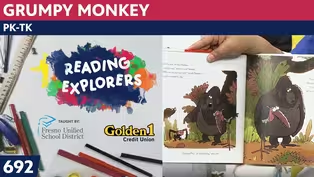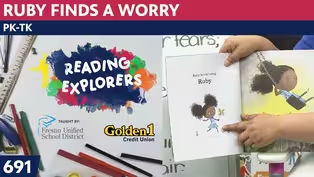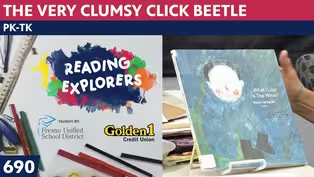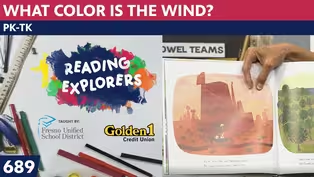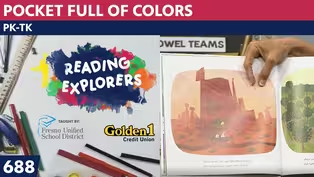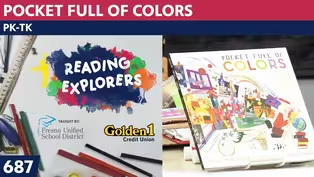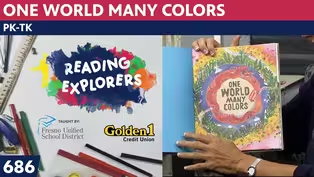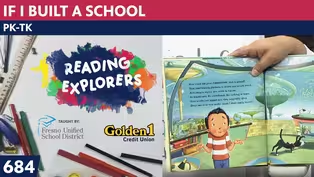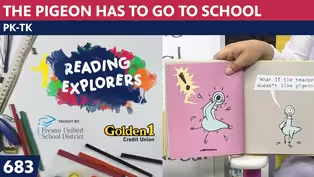
PK-342: Exploring Parts Of A Plant
Season 3 Episode 227 | 14m 13sVideo has Closed Captions
Join Mrs. Lara at Camp Discovery!
Pre-Kindergarten teacher, Mrs. Lara, welcomes students back to Camp Discovery, a fun learning space packed with reading adventures & fun games!
Problems playing video? | Closed Captioning Feedback
Problems playing video? | Closed Captioning Feedback
Reading Explorers is a local public television program presented by Valley PBS

PK-342: Exploring Parts Of A Plant
Season 3 Episode 227 | 14m 13sVideo has Closed Captions
Pre-Kindergarten teacher, Mrs. Lara, welcomes students back to Camp Discovery, a fun learning space packed with reading adventures & fun games!
Problems playing video? | Closed Captioning Feedback
How to Watch Reading Explorers
Reading Explorers is available to stream on pbs.org and the free PBS App, available on iPhone, Apple TV, Android TV, Android smartphones, Amazon Fire TV, Amazon Fire Tablet, Roku, Samsung Smart TV, and Vizio.
Providing Support for PBS.org
Learn Moreabout PBS online sponsorshipMore from This Collection
Valley PBS and Fresno Unified School District have partnered with Golden 1 Credit Union to create Reading Explorers Lessons for grades Pre-Kindergarten through Third grade. The daily lessons will be taught by Fresno Unified School District teachers and are created to help students practice their reading skills and reinforce lessons during distance learning.
Video has Closed Captions
Valley PBS presents Reading Explorers Lessons for Pre-Kindergarten and TK. (26m 27s)
PK-TK-693-The Most Magnificent Thing
Video has Closed Captions
Valley PBS presents Reading Explorers Lessons for Pre-Kindergarten and TK. (26m 26s)
Video has Closed Captions
Valley PBS presents Reading Explorers Lessons for Pre-Kindergarten and TK. (26m 28s)
Video has Closed Captions
Valley PBS presents Reading Explorers Lessons for Pre-Kindergarten and TK. (26m 28s)
PK-TK-690: The Very Clumsy Click Beetle
Video has Closed Captions
Valley PBS presents Reading Explorers Lessons for Pre-Kindergarten and TK. (26m 22s)
PK-TK-689: What Color is the Wind?
Video has Closed Captions
Valley PBS presents Reading Explorers Lessons for Pre-Kindergarten and TK. (26m 21s)
PK-TK-688: Pocket Full of Colors
Video has Closed Captions
Valley PBS presents Reading Explorers Lessons for Pre-Kindergarten and TK. (25m 58s)
PK-TK-687: Dancing Through Fields of Colors
Video has Closed Captions
Valley PBS presents Reading Explorers Lessons for Pre-Kindergarten and TK. (26m 20s)
PK-TK-686: One World Many Colors
Video has Closed Captions
Valley PBS presents Reading Explorers Lessons for Pre-Kindergarten and TK. (27m 13s)
PK-TK-685: School is Wherever I am
Video has Closed Captions
Valley PBS presents Reading Explorers Lessons for Pre-Kindergarten and TK. (26m 32s)
PK-TK-684: If I Built a School
Video has Closed Captions
Valley PBS presents Reading Explorers Lessons for Pre-Kindergarten and TK. (26m 21s)
PK-TK-683: The Pigeon Has to Go to School
Video has Closed Captions
Valley PBS presents Reading Explorers Lessons for Pre-Kindergarten and TK. (26m 22s)
Providing Support for PBS.org
Learn Moreabout PBS online sponsorship(happy guitar music) ♪ Good morning to a brand new day ♪ ♪ Time to learn and games to play ♪ ♪ Learning things is so much fun ♪ ♪ Learning is good for everyone ♪ (playful music) - Hello, little learners.
Welcome back to our learning space.
My name is Miss Lara.
Can you tell me your name?
I'm so glad that you made it back this week.
We have so much learning to do.
So let's start off our day with a fun greeting song.
I have my friend here to help us.
Are you ready?
♪ Good morning, good morning ♪ ♪ It's a sunshine kind of day ♪ ♪ Come join Miss Lara for some learning and some play ♪ ♪ Will we sing a song ♪ Of course, we will.
♪ Make our brains strong ♪ Like super strong.
♪ So come along ♪ Yes, come on, friends.
♪ For some learning and some play ♪ So let me put my insect away and we'll go through our visual schedule.
So we're doing our emotional check-in with the shark song this week.
And I have my shark ready to go here.
And remember an emotional check-in is something you want to do throughout the day.
Miss Lara tells you all the time.
But remember to check in on those around you.
Ask your parents, how are you feeling today?
That's a really, that's a good way to be a friend.
Then we're gonna do our weekly investigation.
And we're focusing on the book "The Tiny Seed" by Eric Carle.
Today, we're gonna be taking apart a real-life plant and thinking through what are some of the parts that we observe.
And then we'll end our day with an activity and a song or a wave goodbye.
Sound like a good plan?
Okay, I have my shark ready.
He was a little crazy bananas last time, but here he is, our feelings shark.
So you know that song.
♪ Doo-Doo, doo-doo-doo-doo ♪ He's gonna make some feelings happen.
Ready?
♪ Feelings shark doo-doo, doo-doo-doo-doo ♪ ♪ Feeling shark doo-doo, doo-doo-doo-doo ♪ ♪ Feeling shark doo-doo, doo-doo-doo-doo ♪ ♪ Feeling shark ♪ ♪ Feel so sad, doo-doo, doo-doo-doo-doo ♪ ♪ Feel so bad, doo-doo, doo-doo-doo-doo ♪ ♪ Wants to cry, doo-doo, doo-doo-doo-doo ♪ ♪ Feels so sad ♪ ♪ Now he's happy, doo-doo, doo-doo-doo-doo ♪ ♪ He wants to smile, doo-doo, doo-doo-doo-doo ♪ ♪ He wants to dance, doo-doo, doo-doo-doo-doo ♪ ♪ He wants to jump ♪ ♪ Now he's silly, doo-doo, doo-doo-doo-doo ♪ ♪ Wants to prance, doo-doo, doo-doo-doo-doo ♪ ♪ Wants to smile, doo-doo, doo-doo-doo-doo ♪ ♪ Oh, so silly ♪ Now, remember, you don't need a fancy shark puppet to do that, even though I kind of made this one with just some great fabric and glue.
You can pretend to be a shark by putting a fin on your head like this and singing the song.
Okay, now I have something behind my board that's gonna tell us what we're gonna do in our activity table.
So let me give you a letter clue.
Here we go.
So, our letter clue starts off with a big line.
Now, do you remember where we start our letters?
That's right, we start them at the top.
When we write, we start our letters at the top because that helps us write quicker.
And when you get to kindergarten, and first grade, and third grade, all you do is write, write, write, super fun.
Then, you're gonna take a little curve and put it right at the top like this.
What letter have I made?
It's the letter P, that's right.
P for plant.
And that was the focus of our text, "The Tiny Seed."
It was plants, wasn't it?
So, I'm going to show you a picture, a drawing of a plant.
And it's only labeled at the bottom.
This is because I want us to explore the different parts of the plants before we label them.
Later, we're gonna write the words.
But when you look at the drawing, what do you notice?
There's a big bunch of... Hmm, something here.
And there's something here holding it up, and maybe some, do you know what these are called?
Yeah, that's right, leaves.
I wonder what those do.
There's some dirt that the plant is being held up in.
And then there's these things here at the bottom.
Hmm, what could those be called?
Oh.
So now, I want us to put our scientist head on.
Remember, scientists use the world, they use their five senses to explore the world around them.
They ask and answer questions about things that they're curious about.
For us, we're gonna be asking and answering questions about a plant.
So our question is, what are the parts of a plant?
We're gonna use the frames I see, I think, and I wonder.
So we have our plant here.
We're gonna put on our gloves just like this.
I have my blue polka dots gloves on because I want to protect my hands from the dirt.
Now, if you don't mind getting a little dirty, you do not need gloves, these are optional.
Now, I went to the hardware store and I picked out these plants.
They're plants that I'll later plant in my garden.
I want us to take a look.
What do you notice about these plants?
Hmm.
Looks like they have a lot of green, don't they?
And they stand straight up.
I wonder how and I wonder why these are purple and yellow.
What purpose does that serve?
Why are they colorful?
Hmm, lots of questions.
That's what a good scientist does.
So I'm not poke it out.
We're gonna get a good view of some roots when I can get these out.
(wrapping crinkling) They are what's called root-bound.
So they're really in there.
And make some noise and cut it out.
Whoo!
Look at these things right down in here.
Sorry if it's a little noisy, friends.
They don't want to come out of their home.
We have experimenting to do.
So, look, right in there.
What do you notice?
What are those things here?
All these white parts.
They're kind of coiled together.
What do you think they are?
Hmm.
And as I'm pulling them apart, it looks like they're kind of condensed and together.
Let me smell them.
Remember, scientists use all their senses to investigate.
Right now, I'm trying to notice what are the parts of a plant.
So I'm noticing these little stringy things at the bottom.
I bet they have a name, so, hmm.
Ooh, smells like wet dirt.
Have you ever been outside when it's raining?
That's what it smells like.
Okay, so as I'm looking, I'm seeing some of those white things, I'm gonna take it apart.
Then I'm seeing this kind of straw-looking thing that's green and it is holding the plant up.
So do you notice right here?
This is holding the plant up.
What do you think that that does?
Huh?
Why do you think it's holding it up like this?
And then I'm noticing these green things.
So I'm wondering what those green things do as well.
Taking it apart.
Now, boys and girls, remember when we made a magnifying glass?
And you can use a pretend one or a real one.
What I'd like you to do is I'd like you to go in your back yard and get a little bit dirty.
Ooh, look at that big root right there.
Whoo, it didn't want to come out.
And I want you to dig up a plant.
So it does not have to be a flower.
It can be a weed.
It could be even a piece of grass.
And I want you to take a look at it like I am here.
What do you notice?
Hey, so as we're looking, we saw that there is something holding up the flower up here, it's very colorful.
There's these string-like things at the bottom and lots of green leaves.
So now it's gonna be time to add names to the plant's parts that we observed.
So boys and girls, these stringy things here at the bottom are called roots.
Can you say that with me?
Roots.
What they do is they anchor into the ground.
They hold onto the ground and they suck up water from the dirt that falls when it rains and they bring it up to the plant.
So they're like a straw that gets all the water from the garden, brings it up like that.
And then, this really long part here, you can see, this part is called a stem.
A stem holds up the flower part, and it's also responsible for taking water and bringing it up through the flower.
So the flower can take a drink.
And then, this top part here is the flower part.
Now, this part is very important because how the flower reproduces or makes itself again is when bees come and they go into the flower and they extract the pollen, or the pollen gets stuck on their bodies and they go to other flowers and that's how the flowers reproduce or make themselves again.
So that's why the flowers are very colorful to attract bees.
And then we have a last part here that I noticed.
It's the leaf, okay?
So the leaves actually act almost like umbrellas.
So they take the sunlight that comes down onto the earth, and they actually turn it into food for the plant in a process called photosynthesis.
You know how us grown-ups love to name things fancy names.
Okay, so let's review what we saw, what we thought, what we wonder, and then we'll sing our goodbye song after that.
Take off my gloves.
So we saw...
So our question was, what are the parts of a plant?
So I see, so we got to see the plant's root system.
We got to see the stem.
We got to see the leaves, and we even got to see the flowering part.
I think, hmm.
I think that plants are colorful for a reason.
We talked about the bees coming to them.
But I wonder if they're also colorful so that we can enjoy them.
And my last I wonder.
Do you have an I wonder?
I wonder why some plants are tall and some plants are small.
How can we find out?
Yes, we can read books.
All right, my friends, I want you to do some investigation and some digging in your own backyard, look for plants.
And if you find a really neat plant that you want to send a picture of, send it here to the station.
I love reading your letters and getting your pictures.
And if you include your address, you get one of these fancy activity books that has lots of fun characters and activities that you can do at home on your own.
I loved getting mail when I was a kid.
All right, boys and girls, we have just enough time to do our goodbye song.
Are you ready to sing it?
It goes like this.
♪ A, B, C you later ♪ ♪ D, E, F, G, I'm gonna miss you ♪ ♪ H, I have to go now ♪ ♪ J, K, bye-bye now ♪ ♪ L, M, N, O, I had a good time ♪ ♪ P, Q, R you gonna miss me ♪ ♪ S, T, U are my best friend ♪ ♪ V, W, X, Y, Z ♪ Now, boys and girls, I hope that you come back tomorrow.
We have so much to do.
Hey, tomorrow is a special day.
I hope that we don't get a visitor.
So tomorrow is St. Patrick's Day.
And you know who comes out on St. Patrick's Day.
Leprechauns.
That was the special visitor I was telling you about.
They are tricky little creatures.
So let's come back tomorrow and see what they did here to the studio.
I hope they were good.
And then we're gonna continue learning about plants, the plant life cycle, and even get to make our own Eric Carle flower, using his special collage technique.
All right, until then, Miss Lara is gonna send you a big squeeze and a big smooch (lips smack), and remind you to read and to play, and to use your imagination every single day.
Go explore your yard.
See what plants you find.
Goodbye.
(happy guitar music) ♪ Good morning to a brand new day ♪ ♪ Time to learn and games to play ♪ ♪ Learning things is so much fun ♪ ♪ Learning is good for everyone ♪
Support for PBS provided by:
Reading Explorers is a local public television program presented by Valley PBS
